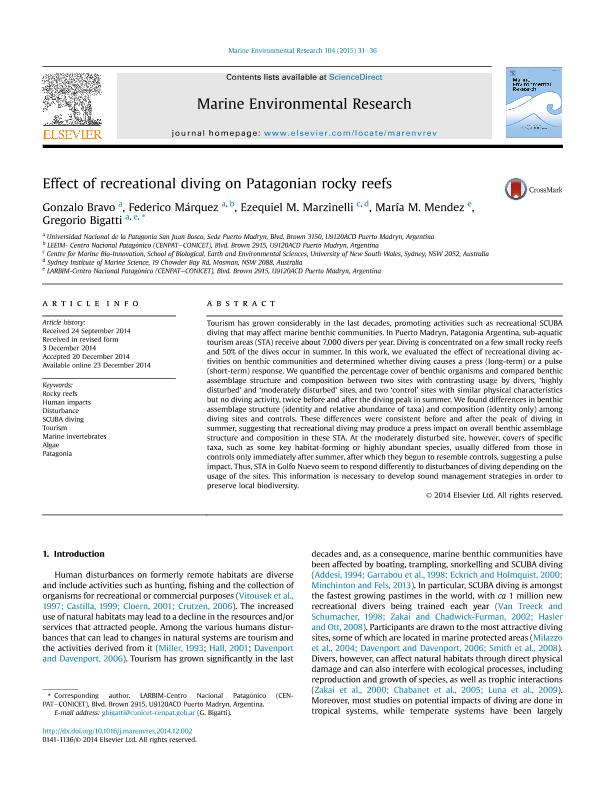Mostrar el registro sencillo del ítem
dc.contributor.author
Bravo, Gonzalo

dc.contributor.author
Marquez, Federico

dc.contributor.author
Marzinelli, Ezequiel M.
dc.contributor.author
Mendez, María Martha

dc.contributor.author
Bigatti, Gregorio

dc.date.available
2017-12-11T16:41:03Z
dc.date.issued
2014-12-23
dc.identifier.citation
Bravo, Gonzalo; Marquez, Federico; Marzinelli, Ezequiel M.; Mendez, María Martha; Bigatti, Gregorio; Effect of recreational diving on Patagonian rocky reefs; Elsevier; Marine Environmental Research; 104; 23-12-2014; 31-36
dc.identifier.issn
0141-1136
dc.identifier.uri
http://hdl.handle.net/11336/30138
dc.description.abstract
Tourism has grown considerably in the last decades, promoting activities such as recreational SCUBA diving that may affect marine benthic communities. In Puerto Madryn, Patagonia Argentina, sub-aquatic tourism areas (STA) receive about 7,000 divers per year. Diving is concentrated on a few small rocky reefs and 50% of the dives occur in summer. In this work, we evaluated the effect of recreational diving ac- tivities on benthic communities and determined whether diving causes a press (long-term) or a pulse (short-term) response. We quanti fi ed the percentage cover of benthic organisms and compared benthic assemblage structure and composition between two sites with contrasting usage by divers, ‘ highly disturbed ’ and ‘ moderately disturbed ’ sites, and two ‘ control ’ sites with similar physical characteristics but no diving activity, twice before and after the diving peak in summer. We found differences in benthic assemblage structure (identity and relative abundance of taxa) and composition (identity only) among diving sites and controls. These differences were consistent before and after the peak of diving in summer, suggesting that recreational diving may produce a press impact on overall benthic assemblage structure and composition in these STA. At the moderately disturbed site, however, covers of speci fi c taxa, such as some key habitat-forming or highly abundant species, usually differed from those in controls only immediately after summer, after which they begun to resemble controls, suggesting a pulse impact. Thus, STA in Golfo Nuevo seem to respond differently to disturbances of diving depending on the usage of the sites. This information is necessary to develop sound management strategies in order to preserve local biodiversity.
dc.format
application/pdf
dc.language.iso
eng
dc.publisher
Elsevier

dc.rights
info:eu-repo/semantics/openAccess
dc.rights.uri
https://creativecommons.org/licenses/by-nc-sa/2.5/ar/
dc.subject
Rocky Reefs
dc.subject
Human Impacts
dc.subject
Disturbance
dc.subject
Scuba Diving
dc.subject
Tourism
dc.subject
Marine Invertebrate
dc.subject
Algae
dc.subject
Patagonian
dc.subject.classification
Otras Ciencias Biológicas

dc.subject.classification
Ciencias Biológicas

dc.subject.classification
CIENCIAS NATURALES Y EXACTAS

dc.subject.classification
Otras Ciencias Biológicas

dc.subject.classification
Ciencias Biológicas

dc.subject.classification
CIENCIAS NATURALES Y EXACTAS

dc.title
Effect of recreational diving on Patagonian rocky reefs
dc.type
info:eu-repo/semantics/article
dc.type
info:ar-repo/semantics/artículo
dc.type
info:eu-repo/semantics/publishedVersion
dc.date.updated
2017-07-27T12:34:28Z
dc.journal.volume
104
dc.journal.pagination
31-36
dc.journal.pais
Países Bajos

dc.journal.ciudad
Amsterdam
dc.description.fil
Fil: Bravo, Gonzalo. Universidad Nacional de la Patagonia; Argentina
dc.description.fil
Fil: Marquez, Federico. Universidad Nacional de la Patagonia; Argentina. Consejo Nacional de Investigaciones Científicas y Técnicas. Centro Científico Tecnológico Conicet - Centro Nacional Patagónico; Argentina. Consejo Nacional de Investigaciones Científicas y Técnicas; Argentina
dc.description.fil
Fil: Marzinelli, Ezequiel M.. University of New South Wales; Australia. Sydney Institute of Marine Science; Australia
dc.description.fil
Fil: Mendez, María Martha. Consejo Nacional de Investigaciones Científicas y Técnicas. Centro Científico Tecnológico Conicet - Centro Nacional Patagónico; Argentina. Consejo Nacional de Investigaciones Científicas y Técnicas; Argentina
dc.description.fil
Fil: Bigatti, Gregorio. Universidad Nacional de la Patagonia; Argentina. Consejo Nacional de Investigaciones Científicas y Técnicas. Centro Científico Tecnológico Conicet - Centro Nacional Patagónico. Instituto de Biología de Organismos Marinos; Argentina. Consejo Nacional de Investigaciones Científicas y Técnicas. Centro Científico Tecnológico Conicet - Centro Nacional Patagónico; Argentina. Consejo Nacional de Investigaciones Científicas y Técnicas; Argentina
dc.journal.title
Marine Environmental Research

dc.relation.alternativeid
info:eu-repo/semantics/altIdentifier/url/http://www.sciencedirect.com/science/article/pii/S0141113614002062
dc.relation.alternativeid
info:eu-repo/semantics/altIdentifier/url/https://www.sciencedirect.com/science/journal/01411136
dc.relation.alternativeid
info:eu-repo/semantics/altIdentifier/doi/http://dx.doi.org/10.1016/j.marenvres.2014.12.002
Archivos asociados
